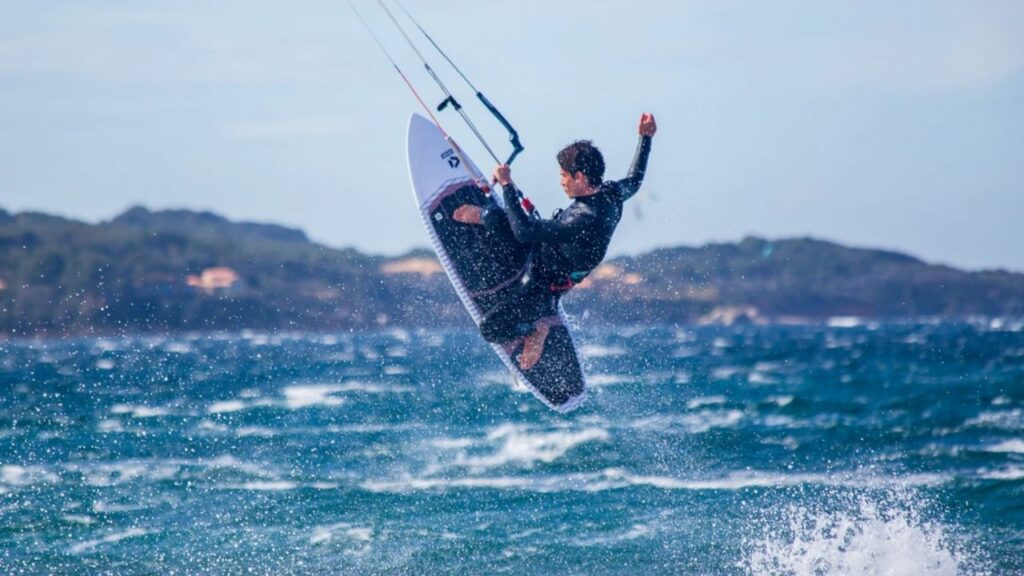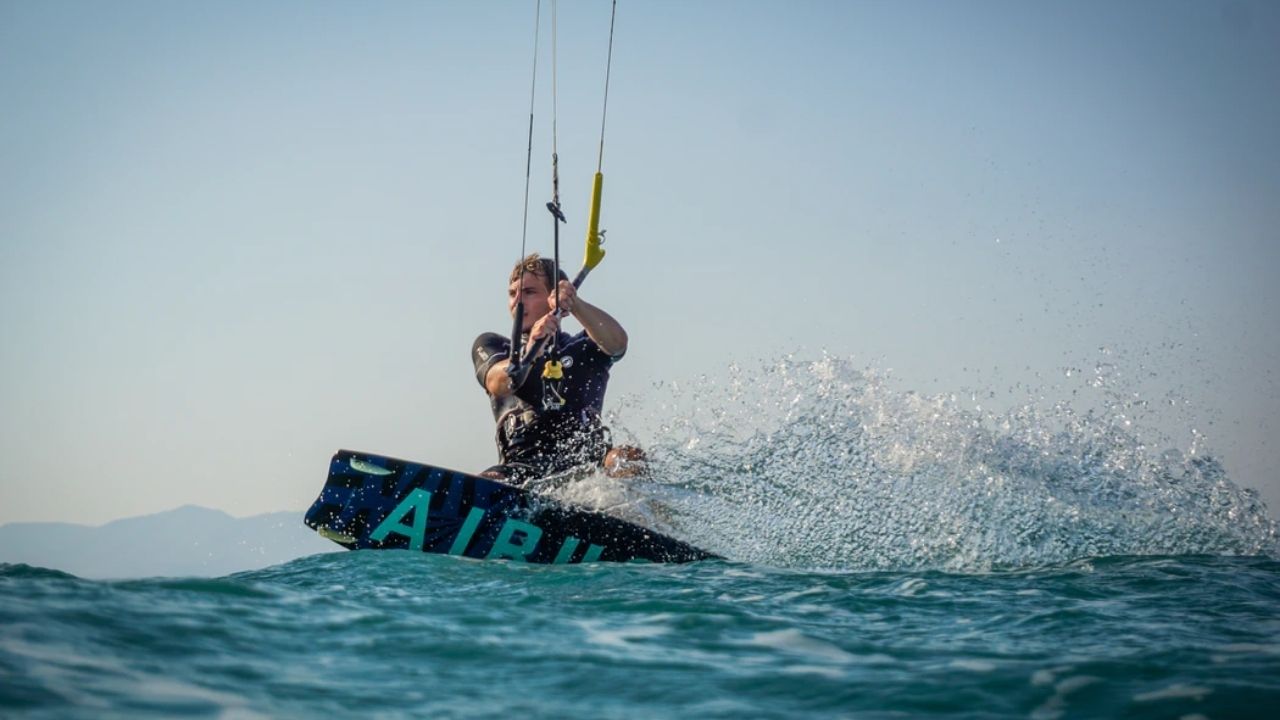As a beginner, I was always confused about favorable and unfavorable winds, wind speeds, and other vital factors. And don’t even get me started on the different board types and kite sizes that depend on your weight.
There are just so many important questions to answer. I mean, what if I choose the wrong surfboard? Or a day and time with the wrong wind speed? I don’t wanna fall headfirst into the water at 10 knots.
Generally speaking, you need the wind speed to be about 12mph (10-11 knots) for kitesurfing. In comparison, heavier riders who weigh over 200lbs would need atleast 13 knots (15mph) for active kitesurfing.
It’s worth noting that the kite can start flying itself (and maybe drag you) at 5-7 knots (about 8mph). But that’s technically not “kiteboarding.”
The kite’s flight in kitesurfing is affected by three metrics: the wind speed, the size of the wing, and your weight.
The latter two are easily manageable (obviously), but “minimum required wind speed” has always had a question mark with different schools of thought. So, what’s the magic number?
Wind Speed Requirement Based on Kite Size
1. How much wind do you need for a 9m kite?
The two questions that I’m asked the most are the amount of wind speed you need, for 9-meter and 12-meter kites. These two are a part of the “beginner hype” category.
An average kitesurfer needs 15 to 20 knots (13 to 17.3 mph) of wind speed to kiteboarding with a 9-meter height. In comparison, heavy surfers (over 200lbs) will need 25 to 30 knots (21.7 to 26mph) for a kite this big.
2. How much wind do you need for a 12m kite?
Light-weighted skilled kitesurfers can use a 12m kite with wind speed as low as 20 knots (17.3mph), but others would need atleast 21.7knots (26mph) for such a huge kite. Heavy-weight surfers need to be highly skilled for bigger kites, and they would need atleast 30knots (26knots).
Does that mean you can use these kites as long as the wind speed is favorable? Unfortunately, no, and here’s why.
3. How much wind is too much wind for kitesurfing?
A non-expert who rides at 10-15 knots can’t do it with a 12m kite. But can a beginner even ride 25-30 knots? Not at all. Everything at 30 knots will be twice as fast compared to 15 knots, and it’ll require THAT MUCH precision.
This is why 9m and 12m kites are never recommended for beginners or even enthusiasts. And why the speed for “too much” wind is different for everyone.
Now, by this logic, heavyweights won’t be able to kiteboard 9m and 12m kites at all because the wind speed would be too high. Yes and No.
Yes, it would be difficult until they get better at precision. Still, their weight or “Moment of Inertia” will always be more than lightweights, so they will be able to control a kite easier than their counterparts.
Other Important Factors for Kitesurfing
Apart from the speed of the wind, you will also need to consider its direction and “ wind quality.”

1. Wind Direction
Once you are floating and surfing, the wind direction will play a bigger role in the overall experience, and frankly, your survival than the wind speed.
You need to focus on riding sideshore and side on-shore winds when kitesurfing only. Side on-shore winds can be a bit tricky to find but they are the ones at a 45-degree angle blowing towards the shore.
Stay away from all other directions because direct onshore winds will thrust you towards the shore leading to accidents. Direct onshore winds are only good for experts who can ride upwind EASILY. A slight misstep will get your board stuck in the sand and you falling face-first at speed you wouldn’t want to.
And offshore winds will, of course, just take you to the sea, making it challenging to come back. What will you do? Swim all the way back? Good luck.
Side on-shore winds are unanimously considered best for the new riders because they have a straight but not-so-direct path to the share. It’s easier to launch and come back and stay close to the shore when riding side on-shore winds.
So if your kite falls down, which will happen quite often with newbies, you can quickly get back to the shore.
Sideshore winds are excellent for riders who have kiteboarding a couple times and are ready to enjoy the activity. They run parallel to the shore so you won’t get huge waves, and shifting between inbound (close to shore) and outbound surfing will be easier.
2. Quality of Wind
Wind quality is somewhat subjective because my definition of stable wind can be different from your definition. Instead of going too technical and telling you what I like, I’ll tell you the things you need to keep in mind.
Firstly, strong and gusty winds are a no-go for beginners.
Weather conditions are also critical because the 10 knots requirement in Summer will be reduced in the spring, fall, and winter seasons. Also, as the wind gets colder, its density increases, so you don’t need the speed to be as high.
3. Quality of Waves
As a beginner, restrict yourself to flat water or a maximum of 2 feet waves first. As and when your level increases, you can try out 3ft+ waves.
4. What are the best kitesurfing conditions?
Steady sideshore and side on-shore winds running 10 to 15knots are the best kitesurfing / kiteboarding conditions for beginners. Advanced surfers and experts tend to go for 15 – 25 knots, thanks to their adept control.
What conditions to avoid while kiteboarding?
The worst possible conditions to avoid while kiteboarding are turbulence, wrong wind direction, and bad weather. Because any misstep could lead to various accidents.
You already know about wind direction so I won’t discuss it again.
If the wind speed is high or too low and you’re unable to maintain your kite properly, just call it a day. Don’t try to kiteboard in such conditions, it ain’t worth the effort or risk.
For example, if the wind speed is about 12 knots but damping down to under 8 knots frequently – that’s a bad sign.
Other obvious circumstance is a thunderstorm – even if it’s nearby. This is the worst-case scenario. Lightning travels at over 40mph and your kite will be the first thing in its way.
Coldwater will also cause trouble because you’ll get hypothermic in 15-20 minutes if the water temperature is under 60 F. Again, this won’t cause concern, but it’ll make things difficult between two consecutive kites re-launch.

Lastly, don’t kiteboard if the beach has a lot of people. Kiteboarding getting banned on a beach is more common than you would think because newbie surfers have been known to hurt people with their kites, hooks, and the kite line.
How much kiteboarding can I do every year?
This depends on the number of lakes you have access to. Some lakes, such as Lake Michigan, have met the requirements for over 70 days, which is not a tiny number but people in Outer North Carolina have a better option – 275 days a year.
It also depends on how much kitesurfing you’re doing on every trip. That, in turn, depends on your skills, condition, and inventory of your equipment and, most importantly, your knowledge about the weather conditions of the beach.
How to choose the right kite size and kiteboard?
Honestly, the number of types of kiteboards is not definite. But you only need to know the main ones: twin-tip, foil, kitesurf, and light wind kiteboards.
Here’s a kiteboard size chart to help you choose:
Kiteboard Size Chart
| Rider Weight (lb/kg) | Kiteboard Size (cm) | Kiteboard Width (cm) |
| 125-150 lb | 56-68 kg | 134-148 | 41 |
| 150-180 lb | 68-81 kg | 140-160 | 43 |
| 180-210 lb | 81-95 kg | 142-165 | 45 |
| > 210 lb | +95 kg | 146-165 | 46 |
There are five types of kites in kiteboarding:
- C Kite
- Bow Kite
- Hybrid Kite
- Supported Leading Edge (SLE) Kite
- Foil Kite
Here’s a kite size chart to help you choose:
Kite Size Chart
| Wind Speed | |||||||||||||
| Rider Weight (lb) | 95 | 110 | 125 | 140 | 155 | 170 | 185 | 200 | 215 | 230 | 245 | 260 | knots |
| Kite Size (m2) | 3 | 3 | 4 | 4 | 5 | 5 | 5 | 6 | 6 | 7 | 7 | 8 | 34 |
| 3 | 4 | 4 | 5 | 5 | 6 | 7 | 7 | 8 | 8 | 9 | 9 | 28 | 32 |
| 4 | 5 | 5 | 6 | 6 | 7 | 8 | 8 | 9 | 8 | 10 | 11 | 24 | 28 |
| 4 | 5 | 6 | 7 | 7 | 8 | 9 | 9 | 10 | 11 | 12 | 12 | 21 | 24 |
| 5 | 6 | 7 | 7 | 8 | 9 | 10 | 11 | 11 | 12 | 13 | 14 | 19 | 22 |
| 6 | 6 | 7 | 8 | 9 | 10 | 11 | 12 | 13 | 14 | 14 | 15 | 17 | 20 |
| 6 | 7 | 8 | 9 | 10 | 11 | 12 | 13 | 14 | 15 | 16 | 17 | 15 | 17 |
| 7 | 8 | 9 | 10 | 11 | 12 | 13 | 14 | 15 | 16 | 17 | 18 | 14 | 16 |
| 7 | 8 | 10 | 11 | 12 | 13 | 14 | 15 | 16 | 18 | 19 | 20 | 13 | 15 |
| 8 | 9 | 10 | 12 | 13 | 14 | 15 | 16 | 18 | 19 | 20 | 21 | 12 | 14 |
| 8 | 10 | 11 | 12 | 14 | 15 | 16 | 18 | 19 | 20 | 22 | 23 | 11 | 13 |
| 9 | 10 | 12 | 13 | 15 | 16 | 17 | 19 | 20 | 22 | 23 | 24 | 10 | 12 |
Now you know the answer to every question and problem that kitesurfing beginners usually face. So, stay safe out there, and happy surfing!

